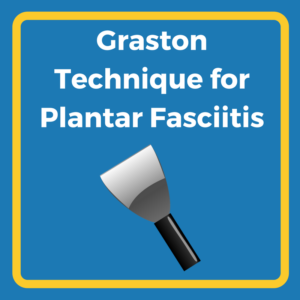 If you’re a sports fan, you’ve likely heard of a treatment method known as the Graston Technique.
If you’re a sports fan, you’ve likely heard of a treatment method known as the Graston Technique.
The Graston Technique, a new, non-invasive treatment for soft-tissue injuries (particularly those where inflammation is present) has been praised by numerous athletes and is gaining popularity outside of the world of sports as well.
What is the Graston Technique? Is it painful? How much will it cost?
And most importantly, does it work?
Here’s what you need to know about the Graston Technique and plantar fasciitis.
What Is the Graston Technique?
In the Graston technique, a physician uses small stainless steel instruments (think of dull butter knives) to apply progressive, targeted pressure to the plantar fascia.
This targeted pressure is intended to break up adhesions in the inflamed, damaged arch, improving blood flow and encouraging the regeneration of healthy tissue. The official Graston Technique is offered by trained physicians who learn how to target and break up adhesions in soft tissue with specialized Graston instruments.
Benefits of Graston Therapy for Plantar Fasciitis

Photo by GTindy CC BY-SA 3.0
Graston Therapy is very similar to other therapies for plantar fasciitis that work to break up adhesions and improve blood flow to the injured fascia (including some remedies you can do at home).
What the Graston Technique offers is highly targeted pressure therapy with specialized instruments. While a rolling pin, golf ball, or mobility ball is quite helpful in breaking up adhesions and improving blood flow, some people find additional benefit in targeted massage and pressure that’s administered by a clinician who can apply highly targeted pressure.
Many people report significant pain relief in the days and weeks following Graston Therapy as blood flow improves and adhesions and scar tissue break down.
Considerations When Using the Graston Technique
While some people experience only mild discomfort throughout treatment with the Graston technique, many individuals do find the process somewhat painful as increased pressure is applied with the instruments.
Common side effects of the procedure are mild and include bruising, redness and soreness in the days following the procedure. Don’t be afraid to communicate with your physician throughout the procedure; the Graston technique can be adjusted and pressure reduced depending on a patient’s unique needs.
Most people undergo Graston therapy for a period of four to six weeks, with a frequency of once or twice a week. Graston therapy may be covered by your insurance provider and typically runs approximately $60-$90 per session.
Supplementing the Graston Technique
Studies on the effectiveness of the Graston Technique are still ongoing, but many reports show promising results. However, some questions remain as to whether the Graston Technique is more effective than simple self-massage with a golf ball or mobility ball.
Compared with many plantar fasciitis treatments, the Graston Technique is non-invasive and inexpensive with few side effects. If you have found success with simple massage tools and wonder if Graston is right for you, there’s little reason not to give this technique a try.
In all cases, Graston Therapy (and other massage and pressure treatments) should be supplemented with treatments that target the root cause of plantar fasciitis. Treating the symptoms without treating the source of your foot and heel pain can result in a chronic condition or worsening symptoms.
Incorporate simple daily stretches into your routine to strengthen the plantar fascia and surrounding muscles and ligaments, wear orthotic inserts to lift the damaged fascia to its optimal height while easing pain, and address other trouble spots like ill-fitting footwear, insufficient rest for your feet during the day, or weight gain that is putting added strain on your arches.




How is this different from ASTYM?